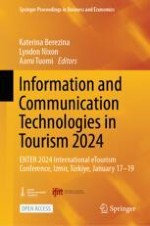1 Introduction
2 Literature Review
2.1 E-Learning in Tourism
2.2 Design Thinking
3 Methods
3.1 Data Collection
3.2 Data Analysis
4 Results
4.1 Sample Profile
4.2 Developing Personas
4.3 Using Personas to Improve Online Courses
-
Timely submission of assignments. It is easy to miss a deadline when juggling work, school, and personal responsibilities. Angelica mentioned that she moves the to-dos and deadlines of each module to her personal planner to keep track of all the work that she needs to complete.
-
Extracting the key material from the video lectures that are essential for learning and completing the assignments. Angelica may have a lot of interruptions in her learning schedule. She acknowledged that she makes progress on her online classes whenever she has time. Therefore, she may be trying to learn at various opportunities, such as short breaks at work, waiting for a meeting, or interrupted circumstances.
-
Lacking real-time interactions. Angelica is taking an asynchronous class online. The course does offer interactive elements, such as the kick-off meeting at the start of the semester and discussion boards for the students to interact and exchange ideas. However, the discussion boards may take time for students to respond to as everyone learns on their own schedule. Therefore, Angelica is looking for ways to increase her interactions with other learners and the professor.
-
Gaining experience. Overall Angelica enjoys her learning experience and values the material that she has been exposed to. However, she does not feel confident yet applying this content to real-life problems and situations (Table 1).
Calendar/Announcements | Video Lectures/Resources | Assignments/Projects | |
|---|---|---|---|
Timely submission of assignments | Create a shareable course calendar that students can import and receive reminders Send out weekly announcements describing the scope of work Send a reminder to students without submissions 2 days before the due date | Add timestamps to video lectures to facilitate navigation to the right content needed for the assignments Provide students with useful methods and apps that help them manage their time Provide learning materials in advance to allow flexibility in working through them | Break down complex assignments into smaller, scaffolded tasks Scaffolding of term projects Provide rubrics to clearly indicate the key concepts and skills students need to develop Provide an estimated time of completion Choice-based projects: Provide students an option to choose a project that aligns with their interests and time availability |
Extracting key material from video lectures | Add a label for essential and supporting video lectures Include instructions on the elements to pay attention to when studying a particular resource (e.g., articles, reports) | Include links to relevant video lectures in the description of the assignment Encourage students to create visual aids like concept maps or diagrams to represent key concepts and relationships within the video lecture | |
Lacking real-time interactions | Periodically schedule live question-and-answer sessions | Enable the web conferencing feature in LMS so that students can organize meetings without the instructor | Ask students to collaborate on small projects in teams for certain weeks Use peer review assignments where students provide feedback to their classmates |
Gaining experience | Give real-life examples and case studies Record interviews with guest speakers Organize online guest lectures Use virtual tours (e.g., Hyatt in virtual reality) | Assign students to keep reflective journals or blogs where they document instances where they've applied class knowledge in their daily lives Partner with a local hospitality/tourism business for projects Use role-playing exercises |
